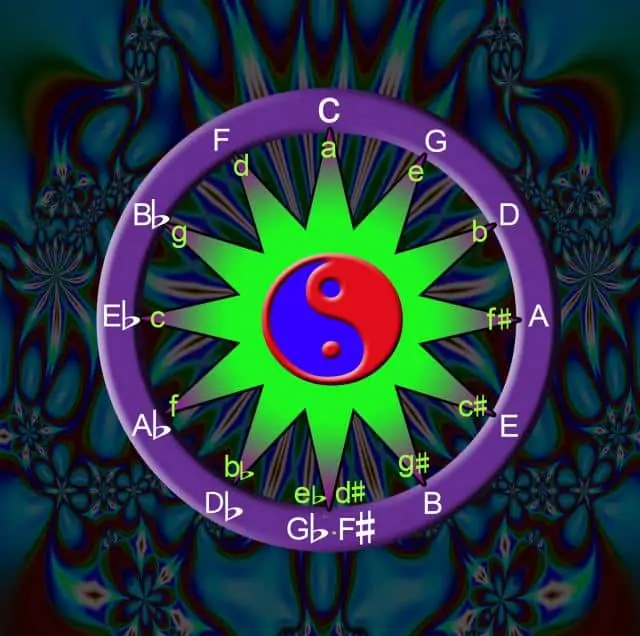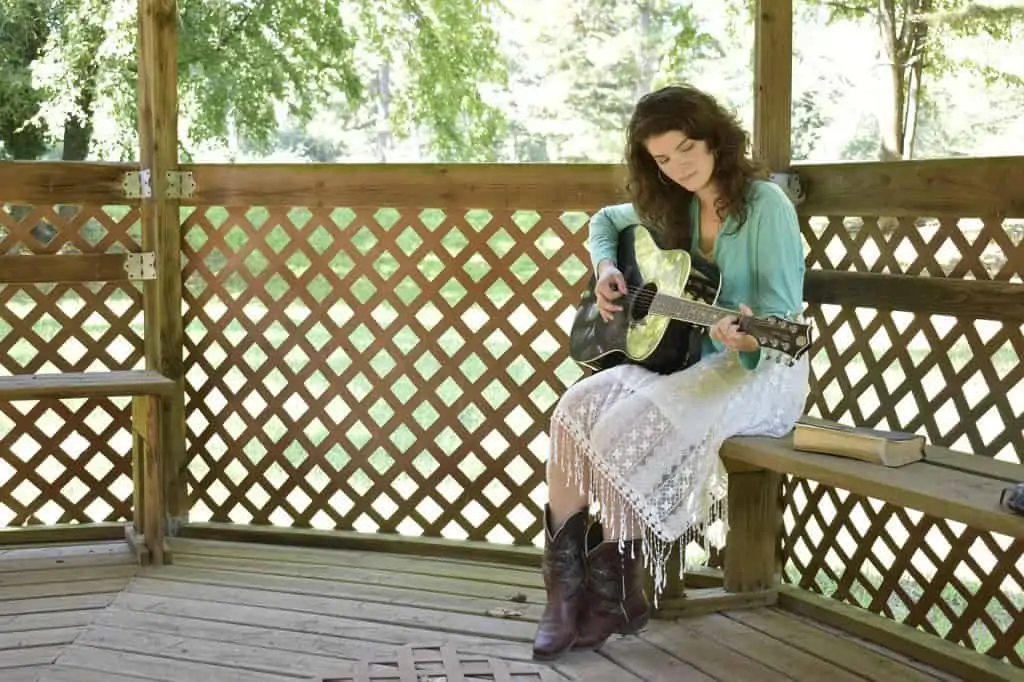So many songs are written in major keys, especially in pop music. So when you hear one in a minor key, it’s quite noticeable. Even if you don’t know exactly what it is, you can just hear and feel that there’s something different. Often these songs in a minor key are some of the most beautiful and often sadder songs.
Minor chord progressions do tend to sound sad. But that isn’t the only emotion these chord progressions can provoke. Rather, think of them as adding flavor to songs. So if you want a poignant song that makes people think about the lyrics, minor keys can help with that.
You can evoke nostalgia, a sense of longing, make a song sound more serious, rock out, or simply add some depth. You can even make a song in a minor key that’s funky or kind of happy.
Minor keys can also modulate (change to another key) into a major key and back for even more intricacy. So you can let your creativity really flow and make diverse music that stands out.
Writing Music in a Minor Key- Some Helpful Tools
Here are some tools that will be helpful for your songwriting:
The Circle of Fifths
Whenever you write music, I highly recommend using the circle of fifths. Whether you memorize it or have it open on your computer or phone, or on the wall to look at.
The right-hand side is the sharp side, the left-hand side is the flat side as you may have guessed. The outside of the circle has major keys and the inside has minor keys. These are the relative minors of each major key. You can find the relative minor for a key by using the 6th interval of the major scale.
For example, C major is:
C, D, E, F, G, A, B
1 2 3 4 5 6 7
You’ll notice in the circle, under the C is A minor. And you can find the relative major of a minor key by using the 3rd interval:
A, B, C, D, E, F, G
1 2 3 4 5 6 7
You may have noticed that C major and A minor are both at the 12 o’clock position, and they have no flats or sharps.
From the 1 ‘o clock position, to the 7 ‘o clock position, the number of sharps follows the “clock” numbers. So G has one sharp, D has two sharps, etc.
The flat side from the 11 ‘o clock position until the 6’o clock position, indicates flats starting from one. So F has one flat, Bb has two flats, etc.
To determine which sharps or flats are in each key, you need to remember the correct order. This order never changes. So look at how many sharps and flats that key has and count the sharps and flats in order to determine which you need.
The Order of Sharps
F#, C#, G#, D#, A#, E#, B#
An easy way to remember it is: Father Charles Goes Down And Ends Battle
Something to note is that B# is actually C, and E# is actually F. This more easily seen on a piano:
The black notes are sharps and flats, the white notes are the whole notes.
So while you will always see these notes as sharps in a key signature in sheet music, you will be playing an F or a C. Same goes for the chords. To demonstrate, you would play an F, Fm, or Fdim, not an E#, E#m, or E#dim.
If you’re just using chords, they will already be written out accordingly.
Order of Flats
Bb, Eb, Ab, Db, Gb, Cb, Fb
A rhyme for that is: Battle Ends And Down Goes Charles’ Father
As you can see in the picture of the piano roll, Cb is B and Fb is E. The same applies for these notes as with C (B#) and F (E#).
The Chords in the Minor Key
If you don’t stray outside the key (playing a chord or two outside the key can add good tension), there is a pattern you can memorize to know which type of chords to use in a minor key:
Minor, diminished, major, minor, minor, major, major.
So if we take the key of E minor, which has one sharp (F#) as you will see in the circle of fifths, your chords will look as follows:
Em, F#dim, G, Am, Bm, C, D.
Here are a few more examples:
The key of C#m has four sharps (F#, C#, G#, D#). Your chords will look as follows:
C#m, D#dim, E, F#m, G#m, A, B
The key of Gbm has two flats (Bb and Eb). Your chords will be as follows:
Gbm, Adim, Bb, Cm, Dm, E, F
Chords According to the Natural, Harmonic, and Melodic Minor Scales
Chords in the Natural, Harmonic and Melodic minor
There are different minor scales. I’ll be focusing on the natural minor scale, the harmonic minor scale, and the melodic minor scale.
The Natural Minor Scale
The natural minor scale adheres to the key signature. So, for example, A minor is as follows:
A, B, C, D, E, F, G
The natural E minor scale looks like this:
E, F#, G, A, B, C, D
The harmonic and melodic scales don’t follow the key signature. This means there are a few more interesting chords you can play, like augmented chords (they have a sharpened fifth).
The Harmonic Minor Scale
The harmonic minor scale differs in that it has a sharpened seventh.
So the A minor harmonic scale looks like this:
A, B, C, D, E, F, G#
Here’s the E minor harmonic scale:
E, F#, G, A, B, C, D#
Chords According to the Melodic Minor Scale
Here are chords we can get from the E minor harmonic scale that aren’t within the key:
- G+ (G augmented: G, B, D#)
- D#
- B
- Em-maj7 (E minor major 7th: E,G, B, D#)
The Melodic Minor Scale
The melodic minor scale is where things get really exciting. In the ascending melodic minor scale, the sixth and seventh intervals are sharpened.
However, the descending melodic minor scale is the same as the natural minor scale.
So let’s take Am again:
↑ A, B, C, D, E, F#, G#
↓ G, F, E, D, C, B, A
This is the Em melodic scale:
↑ E, F#, G, A, B, C#, D#
↓D, C, B, A, G, F#, E
Chords According to the Melodic Minor Scale
So while you would keep all the same chords in the key of Em if you were playing notes in the descending scale. But if you played the notes in the ascending melodic scale, you would get the following chords outside the key:
- G+
- F#m
- C#dim
- D#dim / F#m6
- B
- D# half-dim7 (D#m75b)
Popular Minor Chord Progressions
Chord progressions are three or more chords that are put together into a song. In some cases, even two chords. Most pop songs these days are written with four chords. But in genres like jazz, there are often at double that number.
Chord progressions are based off of the intervals in the scale. Here are some of the most popular chord progressions used in a minor key.
As a reminder, here is the chord pattern for the intervals:
Minor, diminished, major, minor, minor, major, major.
I’ll give an example of actual chords using the key of Am: A B C D E F G
Chord progressions are written in Roman numerals, with capitals indicating major, small letters represent minor.
- i-VI-III-VII (1st, 6th, 3rd, 7th) e.g. Am F C G (This one is one of the most popular)
- i- iv-i-VI-V7-i (1st, 4th, 1st, 6th, 5th [7th chord], 1st) e.g. Am, Dm, Am, F, Em7, Am (12 bar blues)
- i-iv-v (1st, 4th, 5th) e.g. Am Dm Em
- i-VI-III-iv (1st, 6th, 3rd, 4th) e.g Am, F, C, Dm
- ii dim-v-i (2nd, 5th, 1st) e.g. Bdim Em Am
- i-ii dim-v-i (1st, 2nd, 5th, 1st) e.g. Am Bdim Em Am
- i-VII-VI (1st, 7th, 6th) e.g Am G F
- i-VII-VI-v (1st, 7th, 6th, 5th) e.g Am G F Em
- i-iv-III-VI (1st, 4th, 3rd, 6th) e.g Am Dm C F
- i-iv-VI-v (1st, 4th, 6th, 5th) e.g Am Dm F Em
- VI-VII-i (6th, 7th, 1st) e.g F G Am
You can use these popular progressions to write your own music. But don’t be afraid to branch out. For example, diminished chords typically like to resolve back to a minor or major, so you’ll notice that there aren’t any progressions in this list with the diminished chords at the back. It’s not necessarily wrong to do that, it’s just not common in music. But if your creativity takes you there, and it sounds good, go for it.
You can also create music with more complexity and tension using sus chords, seventh chords and augmented chords too.
Examples of Minor Chord Progressions in Song
Here are six songs with their chord progression and original key noted:
Progression i-iv-III-VI- Smells Like Teen Spirit (Nirvana) Fm
Progression VI-VII-i- Losing My Religion (R.E.M) Am
Progression i-iv-VI-v- Back to Black (Amy Winehouse) Dm
Progression i-VI-III-VII- Save Tonight (Eagle Eye Cherry) Am
Progression i-VI-III-iv- Turning Tables (Adele) Cm
Progression i- iv-i-VI-V7-i- The Thrill is Gone (BB King) Bm
Conclusion
The minor key is so versatile, spanning across just about every genre, from rock to pop to jazz to blues. It’s really worthwhile to learn some songs in a minor key, and definitely worth it to explore your creative side with the various minor scales.
As you can see, there are quite a few progressions you can use to write songs and you may even recognize them all in songs. I’m sure there are more progressions than that, and as I’ve said, if the mood takes you and you want to do your own thing, if it sounds good, go for it. Even if it’s not strictly within the rules of music theory.

Cheanné Lombard lives in the home of one of the new Seven World Wonders, Cape Town, South Africa. She can’t go a day without listening to or making music.
Her love of music started when her grandparents gave her a guitar. It was a smaller version of the full-sized guitars fit for her little hands. Later came a keyboard and a few years after that, a beautiful dreadnought guitar and a violin too. While she is self-taught when it comes to the guitar, she had piano lessons as a child and is now taking violin lessons as an adult.
She has been playing guitar for over 15 years and enjoys a good jam session with her husband, also an avid guitarist. In fact, the way he played those jazzy, bluesy numbers that kindled the fire in her punk rock heart. Now she explores a variety of genres and plays in the church worship group too and with whoever else is up for a jam session.



